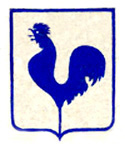Stories & Legends
 |
 |
 |
 |
 |
 |
 |
How the Fleur-de-lis Became the
Symbol of France
We find our legend in the late 13th century poem written at the Abbey of Joyenval at Chambourcy. (2)
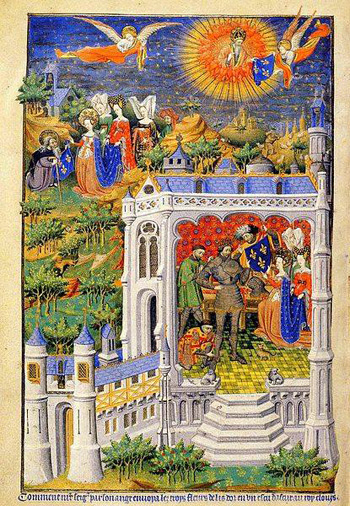
The shield of Clovis, from The Bedford Book of Hours, c. 1423, below, a medieval manuscript records the change from frogs to lilies
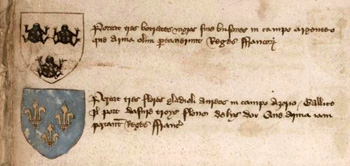
When Clovis returned to his castle, he sought out the mysterious meaning of the three golden fleurs-de-lis. Clotilde told him that the three petals of the flower symbolized the Holy Trinity Who had given him the victory. For God did not want him to bear such a shield with frogs any longer, but had sent to him those three fleurs-de-lis on a blue field so that he would be provided fittingly after he became Catholic.
“Hereby the Holy Trinity gives you victory, my Lord Clovis, so that just as the unity of the three flowers is like gold to your shield, so in perpetuity will your authority reign supreme in golden sovereignty.” (3)
From that time forward the fleur-de-lis replaced the frog and became the symbol of France and its Kings.
And how was it that the three lilies came to appear on the shield of Clovis?
There was a pious hermit who lived nearby the castle, next to a place where the Monastery of Joyenval would later be built. Queen Clotilde at times would consult this holy monk. One day when the hermit was praying an Angel appeared to him with a shield upon which were placed the three fleurs-de-lis against a background the color of a serene blue sky.
The monk told Clotilde of this vision, and she ordered that the frogs should be scratched from Clovis’ shield and replaced with the lilies. With this new symbol from Heaven, delivered in message by an Angel, Clovis won his battle against Conflac. And with this victory, a new era of peace and harmony came to all of France.
And thus the virginal and immaculate lily provided the perfect symbol of the virtue, power and stability of the French Monarchy, under the protection of the Holy Trinity and the Virgin Mary. From the beginning to the end of the Capetian line, the heraldry and iconography of the French Kings included, virtually without exception, a fleur-de-lis either held in a hand, placed atop a scepter or placed on royal robes, shields and seals.
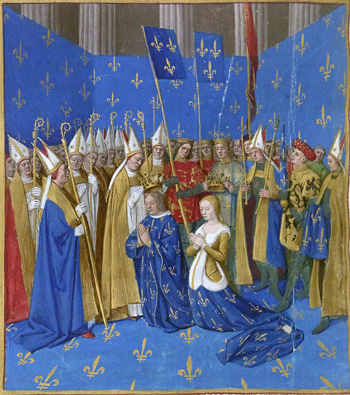
The wedding of King Louis VIII &
Blanche of Castile, 1223
For the lily is painted on thine armor.
Te lillium regem non dubito,
Nam lilium armis depingitur. (4)
By the 13th century the fleur-de-lis was adopted also by the chivalric orders as a symbol of the virtues. Guillaume de Nangis praised the fleur-de-lis and noted its significance thus:
“But since Our Lord Jesus Christ wishes above all other Kingdoms to illuminate the Kingdom of France with the three aforementioned attributes, that is, faith, learning and chivalry, it has become customary for the King to bear on his coat of arms and on his banner the flower of the lily with three petals, as if the three petals said to the whole world: Faith, learning and chivalry thrive more abundantly in our Kingdom than in any other Kingdom, serving us through the care and grace of God. … For faith is governed and ruled by knowledge and is defended by chivalry.
“And furthermore, as long as the aforesaid three are together in the Kingdom of France and are firmly united to each other, the Kingdom will also remain firm. If, however, they should be separated from each other or be torn asunder, everything will be reduced to desolation and will fall into ruin.”
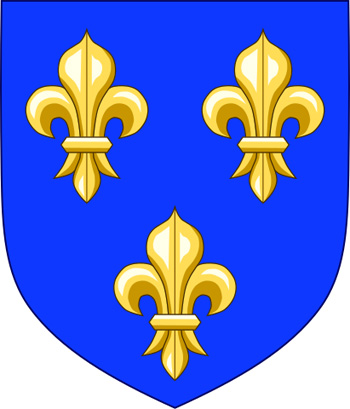
- Bernard of Clairvaux, Sermons, ed. J. Leclercq and H Rochais, S. Bernardi Opera, 5 (Rome, 1958), Sermon 48, pp. 67-73.
- Michael Randall, “On the Evolution of Toads in the French Renaissance.” Renaissance Quarterly, vol. 57, no. 1 (Spring, 2004), pp. 126-164.
- Mary Channen Caldwell, “Flower of the lily': late-medieval religious and heraldic symbolism in Paris,” Bibliothèque Nationale de France, ms français 146, vol. 33 (2014), p. 18, https://www.jstor.org/stable/43304729
- Ibid.

Posted October 28, 2023
